| |
| R-02 FILM EXTRACT: March 2009 |
| Tuesday, 3 March 2009 |
| Sean Sutherland |
Reflective analysis on short film sequence
Our film is a post-apocalyptic zombie movie, where a Human survivor searches for safety while a group of “zombies” chase him. The sequence we shot would come towards the end of the film, as in it we feature a final chase between the Human survivor and the zombies. Also during this scene, the man ends up killing another Human man, and it is this which drives him over the edge. For this scene I wanted to create suspense, tension and a sense of desperation, especially at the end where he kills himself.
My position as cinematographer within our group has allowed me to take camera shots from movies I like and use them in our film. Two of the main movies I like which have influenced me are 28 days/weeks later (Danny Boyle, 2002, 2007). In these films there are many chase sequences which I have used to guide me while creating the film. For instance, the quick cuts between the protagonist and the non-zombie who approaches him are influenced by the chase sequences in the aforementioned movies. 
  Other zombie/creature movies have influenced me where we see point-of-view shots from the creatures’ perspective while an effect is added to create a surreal or other-worldly feeling. Originally I wanted to use a fisheye lens, but instead I opted to add the “blur” effect to the point-of-view shots because I want to emphasize the fact that the zombies used to be human, and as such would still retain human qualities such as the way they see objects. For the protagonist and chase scene, I wanted to create suspense and a sense of claustrophobia, especially as we had limited resources when it came to cast and the location we were in was very open. In order to do this I used a combination of close up shots to create claustrophobia, and still shots of the protagonist running to create suspense, and a feeling of him being watched by something. This is another trait which is very common to zombie movies, such as 28 weeks later, and had limited success. One mistake we made was that during the shot on the left, you can still see our tripod in the background. Other zombie/creature movies have influenced me where we see point-of-view shots from the creatures’ perspective while an effect is added to create a surreal or other-worldly feeling. Originally I wanted to use a fisheye lens, but instead I opted to add the “blur” effect to the point-of-view shots because I want to emphasize the fact that the zombies used to be human, and as such would still retain human qualities such as the way they see objects. For the protagonist and chase scene, I wanted to create suspense and a sense of claustrophobia, especially as we had limited resources when it came to cast and the location we were in was very open. In order to do this I used a combination of close up shots to create claustrophobia, and still shots of the protagonist running to create suspense, and a feeling of him being watched by something. This is another trait which is very common to zombie movies, such as 28 weeks later, and had limited success. One mistake we made was that during the shot on the left, you can still see our tripod in the background.
 My favorite shot from the film is that of the boot crashing to the floor, which shocks and scares the protagonist into falling over the dead body. I liked the way the shot looked, and the shot of the boot makes the viewer feel small and/or insignificant. We also used shots like this at the beginning of the film, where the protagonist runs over the camera. This helps add to the claustrophobic quality of these scenes. A shot almost directly taken from 28 weeks later is that of the first shot, where the protagonist runs into view. This is similar to the scene in 28 Weeks... where Don runs away from the house, into an open and vast field, despite being chased. The only difference really being the fact that, since we didn't have a helicopter, the shot had to be taken on ground level. We attempted to shoot the protagonist directly running into shot, but due to our limited technical skills we had to film the actor in slow motion, and speed him up later. I don’t think it worked, and this is echoed in feedback we have received, but it was the best we could get out of the shot. My favorite shot from the film is that of the boot crashing to the floor, which shocks and scares the protagonist into falling over the dead body. I liked the way the shot looked, and the shot of the boot makes the viewer feel small and/or insignificant. We also used shots like this at the beginning of the film, where the protagonist runs over the camera. This helps add to the claustrophobic quality of these scenes. A shot almost directly taken from 28 weeks later is that of the first shot, where the protagonist runs into view. This is similar to the scene in 28 Weeks... where Don runs away from the house, into an open and vast field, despite being chased. The only difference really being the fact that, since we didn't have a helicopter, the shot had to be taken on ground level. We attempted to shoot the protagonist directly running into shot, but due to our limited technical skills we had to film the actor in slow motion, and speed him up later. I don’t think it worked, and this is echoed in feedback we have received, but it was the best we could get out of the shot.
During the scene, we repeated the same type of quick-cut editing in two separate parts of the  sequence. The first was when the main character stops running and the other human approaches him. I liked the editing in this part as it helped to build tension and I liked the combination of the mid-view of the characters and the point of view from the other Human. The close ups of the gun help to prepare the viewer for the consequence of this meeting. The second time we use this type of editing and a combination of different shots is at the end, where the zombies are approaching the main character. I thought that this worked as well, although feedback has alerted us to the fact that the chase goes on for sequence. The first was when the main character stops running and the other human approaches him. I liked the editing in this part as it helped to build tension and I liked the combination of the mid-view of the characters and the point of view from the other Human. The close ups of the gun help to prepare the viewer for the consequence of this meeting. The second time we use this type of editing and a combination of different shots is at the end, where the zombies are approaching the main character. I thought that this worked as well, although feedback has alerted us to the fact that the chase goes on for  a bit too long to be realistic. Also, a criticism both I and other people share of the sequence is the costume of the zombies. When comparing these costumes to zombies in films such as Boyle’s, ours are laughable. a bit too long to be realistic. Also, a criticism both I and other people share of the sequence is the costume of the zombies. When comparing these costumes to zombies in films such as Boyle’s, ours are laughable.
We had a problem with the portrayal of the supporting characters death, and how to show him being shot. In the end, I decided that the gun should point to the actor, and then we should simply film some of the local landscape. Not only would this solve our problem, but it could also serve as a symbol for the characters return to a natural state (death) and how peaceful a world without Human activity is. Labels: Sean Sutherland |
posted by AS Film Studies Students @ 07:14  |
|
|
|
| Film evaluation |
Film studies – evaluation
Inspired by the chase scene at the beginning of the zombie, thriller movie – 28 weeks later (Boyle 2007), we decided to reproduce another zombie chase scene. We wanted our short film to produce a similar amount of tension to the original footage, as well as emphasise the action that is happening within the sequence.
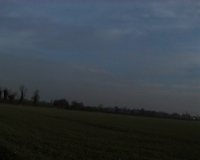
A post apocalyptic/thriller movie needs to create a sense of suspense for the audience as well as emphasise the action on screen. I achieved this through the use of quick editing as well as taking full advantage of point of view shots in order to create a strong sense of tension as characters close in on other characters. I also dimmed the lighting of all of our final footage in order to enforce the gloomy mise en scene of a post apocalyptic movie.
I am especially proud of the editing I did leading up to the gunshot. By mixing shots of the gun with the character walking towards the protagonist, I was able to communicate the possible fate which the character might face. Creating tension as the audience watch the character gets closer to there potential doom. The only problem with this technique was that at the end of the sequence, a similar technique was used to show the final death of the character. The shots switched back and fourth to the character and to the zombies closing in on him. I felt this style of editing was being overused in our sequence and didn’t provide enough variety to interest our audience.
I tackled this problem by merging a third shot with the first cuts, leading up to the gunshot. We had shot a point of view shot that closed in on to the back of the protagonist. Originally this shot was there to emphasise the idea of something following the protagonist. I found this shot was more effective when placed in-between the shots of the gun and the character moving in on the protagonist. Not only did this help create more variety in my style of editing but also helped to foreshadow the event of a chase. (This occurs at the end of the clip). I also made use of a zoom, special effect which makes the camera appear as if it’s pulling away from the center of the shot. This intensifies the action within the footage and helps to present the zombies in a more fearful light. I also slightly changed the colouring during the point of view shots to help give impression the audience where looking through the eyes of something inhuman. This effect also helped to construct the threatening mise en scene of the footage as it drew to its climax.
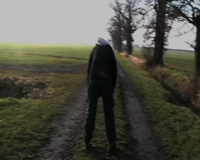 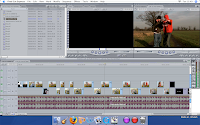 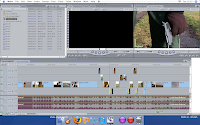
One piece of feedback we had received after people had finished viewing our footage was that we should have spent more time shooting the protagonist alone within the setting. After reviewing our final piece, I would have to say that I agree. The quick editing in the footage does create a sense of urgency which is ideal for a thriller, but it has also made the piece quite short. By adding more shots of the protagonist alone in the setting we could have built up a web of intrigue that would have caught the audience’s attention and also helped to build up the conventions of a typical thriller. By including shots with a longer duration in our piece, we could have also helped to create breaks within the action of the piece, allowing for suspense to rebuild.
If I were to do the project again, I would have liked to spend more time working on the soundtrack to our short clip. Unfortunately due to requiring extra time to gather footage, less time was spent on making the best possible soundtrack. The sound which was created was befitting to the mise en scene of the piece and helped present a mood to the audience. However if we had worked the soundtrack closer with the editing, we could of produced a soundtrack that shared a relationship with the visuals. For example – our footage included a shot of a boot stamping down on the earth. We could have placed noise there to help highlight the importance and impact of that shot. We also could of included diagetic noise into our footage, such as footsteps and breathing. These would have also helped to build suspense alongside the cuts between the gun and the character moving towards the protagonist. I would also have liked to spend more time concentrating on the costume of the characters so as to add more to the mise en scene.
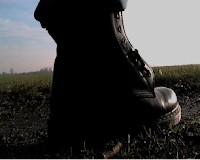 |
posted by AS Film Studies Students @ 07:03  |
|
|
|
| Recent Posts |
|
| Post Archive |
|
|
| Post Labels |
|
|
| All FILM EXTRACT Blogs |
|
|
|
|
|

